 “George… hands”. I was 22 at the time and this seasoned piano mover was a man of few words. When things at the local piano store were slow, they would send me as a swamper, a helping hand to move pianos. Cigarette hanging out of the corner of his mouth, tanned and etched lines in his face, I always found it amusing that he called any young guy “George”. I mean, why bother trying to learn someone’s real name? He would always say it with a smirk pretending as if he didn’t know. If we were delivering to a small town three hours outside the big city, that meant 6 hours driving there and back. Most of the time we rode happily in silence.
“George… hands”. I was 22 at the time and this seasoned piano mover was a man of few words. When things at the local piano store were slow, they would send me as a swamper, a helping hand to move pianos. Cigarette hanging out of the corner of his mouth, tanned and etched lines in his face, I always found it amusing that he called any young guy “George”. I mean, why bother trying to learn someone’s real name? He would always say it with a smirk pretending as if he didn’t know. If we were delivering to a small town three hours outside the big city, that meant 6 hours driving there and back. Most of the time we rode happily in silence.
“George… hands”. Again I was admonished. When moving pianos, you always place your hands on the outside edges so you can feel if you come close to a wall rather than scraping the piano. He would then quote what has become my favourite piano moving line, “Remember, fingers grow back, pianos do not”. Slightly horrified at the thought of having my fingers pinched between the wall and a piano, I would look up to see him give one of the few chuckles at my expense knowing I was a piano player. “You’ll learn quicker this way.”
Although I only worked with him a short while, he was the most deliberate, cautious and yet efficient piano mover I’ve ever had the opportunity to work alongside with. Seeing me try and muscle pianos he would stop me and simply say “Let the piano do the work”. What did he mean by that? You need to be able to feel the balance and work carefully to tilt, lift and roll these massive instruments.
Want to move your own piano? Before you weigh out this decision (literally and figuratively), let me offer a few facts about moving to help think this through.
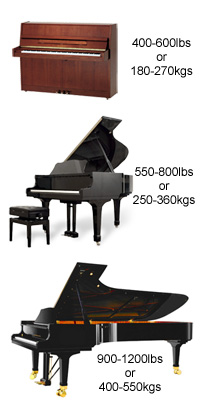 1. Safety first. Last month’s blog we looked at string tension and that there are roughly 19 tons (conservatively) of string pressure on any piano. To keep the piano from buckling under such strain, cast iron was introduced into the piano over 150 years ago. This cast iron plate or frame results in pianos weighing so much. The SMALLEST piano weighs in more than twice to three TIMES the weight of an adult. While average adults weigh anywhere from 130 lbs to 210 lbs, the smallest pianos weigh nearly 400 – 450lbs. A mid sized grand (6’) weighs in at 700lbs. Baby grands and tall old upright pianos, 550lbs. Semi-concert grands come in at about 800-900 while full concert grands that you would see on stage, 1000 lbs – 1200lbs! Before you consider moving a piano, think through the concept that these pianos weigh much more than you do. A tipping piano or one that is moving down a staircase is a force that should not be taken lightly.
1. Safety first. Last month’s blog we looked at string tension and that there are roughly 19 tons (conservatively) of string pressure on any piano. To keep the piano from buckling under such strain, cast iron was introduced into the piano over 150 years ago. This cast iron plate or frame results in pianos weighing so much. The SMALLEST piano weighs in more than twice to three TIMES the weight of an adult. While average adults weigh anywhere from 130 lbs to 210 lbs, the smallest pianos weigh nearly 400 – 450lbs. A mid sized grand (6’) weighs in at 700lbs. Baby grands and tall old upright pianos, 550lbs. Semi-concert grands come in at about 800-900 while full concert grands that you would see on stage, 1000 lbs – 1200lbs! Before you consider moving a piano, think through the concept that these pianos weigh much more than you do. A tipping piano or one that is moving down a staircase is a force that should not be taken lightly.
2. Piano wheels. To be clear, piano wheels are only designed to move away from the wall 6 inches when you need to do seasonal vacuuming. They were NEVER designed for piano moving (the exception being concert grand casters for rolling on a stage but they are still not meant for moving locations). You will never see a piano mover utilising the small 1 or 2 inch wheels of a piano. A rubber wheel piano dolly is the only way to move a piano. Back to point 1, this instrument that weighs 400-1200 pounds 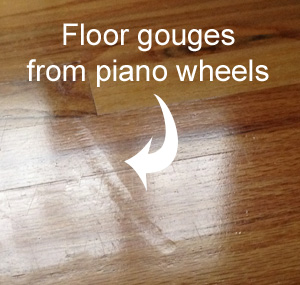 must first be lifted on to a dolly and then wheeled around. The wheels of a piano provide enough force to damage ANY floor. It will crush wood fibers and you will have a difficult if not impossible time getting rid of any dents or roller marks. Even doing the 6 inch move for vacuuming will show marks in the floor if you’re not careful. The dents are subtle but noticeable. See the picture on the left.
must first be lifted on to a dolly and then wheeled around. The wheels of a piano provide enough force to damage ANY floor. It will crush wood fibers and you will have a difficult if not impossible time getting rid of any dents or roller marks. Even doing the 6 inch move for vacuuming will show marks in the floor if you’re not careful. The dents are subtle but noticeable. See the picture on the left.
3. Protection. Piano finishes are durable… relatively. But when faced with rope or strap burns, walls, concrete edges, piano finishes are incredibly soft. Polyurethane finishes (as in black shiny look) are a little like glass ~ they look great until you damage them. Sit them in a room and they can look like new for decades. Dent, scrape or scar them and they are tricky (sometimes impossible) to touch up. Professional movers have thick blankets that protect these finishes. They have straps that are cinched snugly over these pads to protect any movement of the piano against any sharp surface.
4. Transportation. You wouldn’t think it but even moving a 600 lb piano over 2 stairs can be a very difficult task without a ramp. The right equipment makes all the difference in the world. Ramps and skid plates are essentials to the professional mover to roll over surfaces or stairs. Getting a piano onto a truck is another obstacle. The deck of a truck is quite often 3 feet off the ground. All professionals either roll up a ramp or they have a power tailgate that gently lifts it into place.
5. Technique. As previously mentioned, the piano needs to “do the work”. After having moved many a piano, you get a feel for the balance of pianos. While they are cumbersome, I’ve seen many slight-framed movers lift and transport pianos because they understand the balance of the instrument. There are 2 common moving techniques for upright pianos and 1 method for grands.

Upright Moving
A. Did you know that there’s a handle on the back of a piano? It’s built into the back frame. Most movers will position themselves on the end of a piano and then grab under the keybed nearest the front leg of the piano. Lifting the piano on one end, another helper places the 4 wheel dolly under the bottom skid plate of the piano while it is on an angle. Simply by putting the piano down, the piano will then land on the dolly instead of its own wheels.
B. The second method involves having a lifter on each end of the piano who will then lift the piano straight up while a third person places the 4 wheel dolly underneath. It is then easy to roll the piano around the room.
One word of advice: if a piano is on a dolly, it is wise to always have one person with at least one hand on the piano. Leaving a piano unattended on a roll-able surface can be cause for tipping or rolling away on an inclined surface.
 Grand Moving
Grand Moving
Grands must first be tilted onto a grand skid. To do this, professional movers do what is called “dropping a leg”. The pedals are first removed. On the keyboard side, the left corner must first be lifted up while a second mover removes the leg. The piano will, on its own accord want to angle towards the floor. With two movers, the piano can then be safely angled downwards onto the protective (and blanketed) skid. With the full weight of the piano on the corner, the left flat side of the grand can be tilted so that the piano is standing up vertically. And yes, it’s completely fine to have a piano angled in such a direction. It’s how all grand pianos are moved. With the piano safely in an upright position, the other 2 legs can be removed.
The piano is then securely strapped and blanketed to the skid, which is an L-shaped protective layer of wood and carpet (or other softer material). Once the grand piano and the skid have become essentially one movable piece, it can then be tilted (from the round end of the grand) and a dolly can be positioned underneath.
Now what?
Placing a piano is only the beginning stage of piano moving. A clear path must be chosen to move the piano out of the room with the least amount of corners, turns and stairs. Ramps are used to bridge over any stairs or ledges. Outside, most ground can be handled by the 4 wheel dolly but at times, on uneven ground, gravel or grass, the ramps (or plywood) can be used to roll over. Once at the truck, it’s simply a matter of pushing the piano carefully to the top of the truck deck. This is much easier said than done. Most amateurs have no idea how heavy a piano can be with its full weight bearing down on an angle.
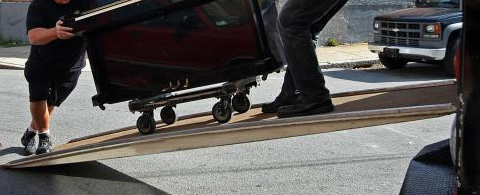 Tie-Downs
Tie-Downs
Remember the days before ratchet straps? People use to use rope. Cinching a piano to the truck is relatively easy so long as the tie-downs are secure and the piano is generously blanketed. The rule of thumb is: No movement. Parts only rub when there is movement to rub. If the piano is secured to the wall or bed of the truck, the piano will not move and subsequently, the theory is that there will be no damage. And ultimately, piano moving is all about safely moving an instrument without getting hurt.
My advice?
Hire a professional. But how do you know if the professionals have experience with pianos? One day I just happened to show up to a technician’s shop just as a piano was being moved out. I asked him “Who’s moving?” The technician replied “I don’t know. The customer already had it arranged.” We waited for awhile and two young guys show up with a dolly. While the company truck was a well-established name, it was apparent that they had substantial turnover in staff and these two had not been on the job long. “Sooooo how do you lift one of these things anyway?”, said the one mover to the other. “They sure look heavy”. RED FLAG. Needless to say, that same piano was brought back the same day as it fell off of the ramp at the customer’s home only this time with substantial damage. How do you know who to hire? There are trucks everywhere saying that they move houses and pianos etc. and quite often, big companies don’t necessarily have trained movers for pianos. In a word, ask those who are in the business. Ask a piano tuner or call a store. They handle pianos every day. They also know who they have entrusted their pianos to for safe delivery.
Disclaimer: I feel strongly about not moving an instrument that puts people into danger. While professional piano movers have moved literally thousands of pianos, doing a one-off to save the few dollars is not worth the risk of injury to yourself or to your piano.
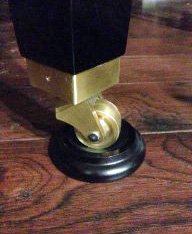 More Thoughts on Piano Moving
More Thoughts on Piano Moving
Moving across the country? Here’s a few thoughts: have you considered factoring in the piano move with your household belongings? If you’re driving with a U-Haul or some other rental truck, you can always hire movers just to get the piano safely on the truck. It’s a small price to pay but then you don’t have to worry about it.
Shipping the piano a long distance? Have you considered freight instead of moving? Freight involves crating a piano so that a forklift can put it onto a semi-truck. For long distance moves, it might be worth investigating that cost. Word to the wise: if you live in sub-freezing temperatures, get a heated truck as well. Pianos don’t particularly like crazy cold climates.
How do I save my floors from a piano? Pianos have casters (small wheels) and so to protect your floors, place the wheels into caster cups – small dishes that prevent the piano from rolling and save your floors.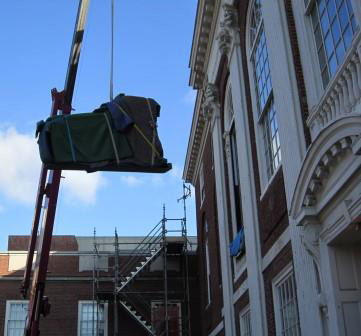
Does my floor need reinforcing before moving a piano in? I have a couch that weighs 100lbs and has a similar “footprint” to an upright piano. Add 3 adult males each at 200lbs and the total would be 700lbs. Where most household pianos weigh 400-600lbs, I’m going to venture and say that structurally your house should be fine to handle any piano without reinforcement. That said, I’ve been in a mobile home once where it appeared that the section where the piano was sitting seemed to sag.
Finally, the piano that won’t fit: I’ve only been involved twice with pianos that literally can’t fit into a space where it was intended. Either the staircases were too tight or doorways and landings too impossible or the piano was simply too big. Although this sounds crazy, pianos can also be positioned by crane. Since I don’t live in New York, I imagine pianos are moved more often by crane than my location. Cranes have a fee attached (obviously) but are more reasonable than you imagine.
More Piano Articles
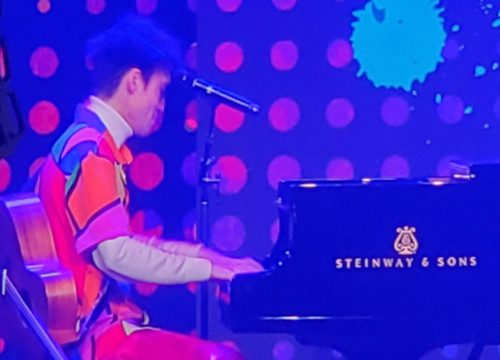
During the performance of Jacob Collier at the most recent NAMM show I was reminded that music makes us human, that beauty binds us together as a collective, and that the reason the music industry exists is to aid in the creation of art. I needed that reminder without which, the annual trade show featuring many of the great piano makers is just the sale of wares. I believe that people are feeling the uncertainty ...

I used to have a teacher who would frequently say, “For every single grade point PAST 80%, it takes as much effort as the FIRST 80.” I believe this statement to be true from experience. The first 80 is the easiest. Chipping away at every point past that is the challenge. The bulk of the work can bring a project into shape but it’s the pursuit of excellence, that’s where the challenge lies. Yamaha is ...

The value of a piano is obvious ~ it’s the music that you make with it. But often, families are going through life changes which involve a house move and unfortunately, the piano needs to be sold. They invariably ask the question, “What are we going to do about the piano?” This question comes up because, as you can imagine, they’re not easy to move. We don’t simply pack them away in a cardboard box ...

You’ve been playing your piano for years now and the time has come to seriously consider downsizing the house and move into a condo. But what do you do with the piano? You love your piano and can’t imagine life without it and besides, you absolutely hate the idea of playing a digital keyboard. Many people don’t know that you can add digital functionality without compromising your existing piano. Yes, it is completely possible to ...

Many years ago, I remember seeing a piano in a museum similar to the one shown above (built in 1787 by Christian Gottlob Hubert. On display at Germanisches Nationalmuseum - Nuremberg, Germany). I have often wondered why acoustic portable pianos never really took off. Although we've seen more portable keyboard instruments like harpsichords, accordions or electronic keyboards, they operate completely different from a traditional piano in that they either pluck the strings, use air with ...

This was the first year since covid that the National Association of Music Merchants (NAMM) trade show was back to its regular January date and, in fact the first show where it felt back to normal. How was it? To answer that, I'm going quickly review the piano market over the last few years. Piano sales boomed during covid. Think about it - everyone was at home and with time on their hands, many turned ...